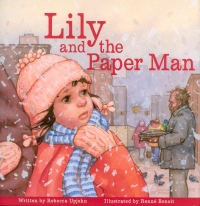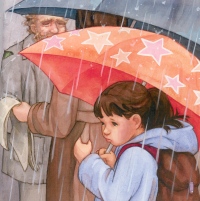| ________________
CM . . .
. Volume XIV Number 3 . . . .September 28, 2007 
 |
Lily and the Paper Man.
Rebecca Upjohn. Illustrated by Renné Benoit.
Toronto, ON: Second Story Press, 2007.
24 pp., hardcover, $14.95.
ISBN 978-1-897187-19-7.
Subject Headings:
Homeless persons-Juvenile fiction.
Compassion-Juvenile fiction.
Preschool-grade 2 / Ages 4-7.
Review by Carolyn Crippen.
**** /4
|
| |
|

excerpt:
"The Paper Man isn't wearing socks, Mama. Why? It's cold out."
Lily's mother looks serious. "I guess he doesn't have any," she says.
"We're very lucky to have warm clothes and a place to live."
Lily is quiet after that and holds her mother's hand all the way to their apartment.
This beautiful picture book links the sad plight of a homeless man with the compassion and energy of a young girl. The sensitive text and matching illustrations blend well to create a story of "making a positive difference" in our world today.
The story begins on a rainy fall day as Lily walks home from school with her mother. They say good-bye to Frank, the school crossing guard. The picture is bright and cheery, and everyone has a smile on his or her face. The reader feels the splash of water as Lily stomps through the puddles in her pink rain boots. Cleverly inserted into the depiction are many safety reminders: hold your umbrella up and back so you can see where you are going; observe the big red STOP sign when crossing the street; cars have their lights on in the rain; hold your parent's hand when walking in a
busy street.
Lily and her mother follow the same route each day past Mrs. Chan's store, and Lily recognizes that she is almost home. Lily demonstrates how she can walk backwards and bumps into something - someone. The Paper Man, who looks "different" to Lily, causes the bump: higgledy-piggledy hair; bumpy nose and beard; and wheezy breathing. Lily is frightened and stays close to her mother while constantly checking behind her as they walk to their apartment. Now the smile is gone from her face.
Fear causes change in Lily's behaviour. She no longer wants to walk home from school; she wants to take the bus. Even while riding in the bus, Lily ducks when she sees the Paper Man outside on the street. The illustration depicts a mood of quiet thought laced with pervasive tension. Lily no longer walks; instead she runs home from the bus stop into the lobby of her building and encourages her mother to hurry too. Her mother senses something is wrong; but Lily does not explain. Once the door handle clicks, Lily feels safe.
Weeks pass until the snow falls. Lily is excited and wants to walk home again. The reader looks down on Lily as she twirls in the snow with her mouth open and tongue ready to catch the falling snowflakes. She enjoys the sound of her boots crunching in the snow as she runs ahead of her mother to Mrs. Chan's for hot chocolate. But, Lily's happy moment is broken when she hears a voice, "A dollar for the paper."
Lily's eyes fly open. The Paper Man holds out a newspaper with a shaking hand. Lily wants to run away but stands still. She sees a thin shirt through the holes on his coat and bare feet through the holes in his boots. Lily shivers.
Lily's mother gives the man a dollar, and then she tucks the paper into her purse. "Thank you," she says.
"Have a good day," says the Paper Man. Lily is not sure, but she thinks he winks at her.
Lily's mind is racing, and she forgets her usual routines to unlock the lobby door and to push the button on the elevator. Her mother talks with Lily about the way she is behaving. This short but insightful conversation paves the way for the remainder of the story.
 Lily and her father go to Mrs. Chan's, and they encounter the Paper Man again who sells a paper to Lily's father and speaks to Lily with a smile. The Paper Man has no hat or mitts; his shoulders are hunched; and his ears are red from the cold. The illustration of Mrs. Chan's store is delightful to the eye: brilliant colours, a variety of articles-from gumdrops to a basket of apples, to stuffed monkeys and elephants on the store floor, all very tempting. Lily ponders what to do. Inside the store, Lily decides not to spend her dollar on a treat for herself.
Lily and her father go to Mrs. Chan's, and they encounter the Paper Man again who sells a paper to Lily's father and speaks to Lily with a smile. The Paper Man has no hat or mitts; his shoulders are hunched; and his ears are red from the cold. The illustration of Mrs. Chan's store is delightful to the eye: brilliant colours, a variety of articles-from gumdrops to a basket of apples, to stuffed monkeys and elephants on the store floor, all very tempting. Lily ponders what to do. Inside the store, Lily decides not to spend her dollar on a treat for herself.
After a good night's sleep, Lily knows what she wants to do. Lily gathers materials with the help of her mother, father, Frank, the school custodian, and Mrs. Chan. Lily works all day, and it is difficult to sleep that night. Even though the next day is Saturday, a good day to sleep in, Lily rouses her parents and wants to go to the Paper Man immediately. The illustration clearly indicates a sleepy perplexed father; a somewhat resigned mother, and a determined daughter who attempts to pull her mother out of the bed.
Lily and her parents go to see the Paper Man. Lily drags a big bag right up to the Paper Man. She is thrilled to see him, and her heart is pounding. A brief introduction and conversation takes place between the homeless man, whose name is Ray, and the little girl and the delivery of a huge bag of warm winter clothing. Lily's parents stand near by. The last item in the bag is Lily's precious baby quilt, made by her grandmother. This is a tough moment for Lily because she loves this quilt.
The Paper Man holds it up and looks at the stars and elephants and turtles. Lily tries to smile, but it is her very favourite quilt. The Paper Man wraps it around himself.
"Thank you, Lily," he says softly.
"Now you are warm," she says, past the lump in her throat.
"I'm warmer that I've been for a long, long time." His eyes sparkle. He smiles the biggest smile Lily has ever seen. Suddenly, she can smile again too.
Altruism is a quality that comes easily for some children. Perhaps this is because of parental example. Throughout the story, Lily's parents were always there to acknowledge the Paper Man by giving him time, money for the paper, clothes for his comfort, and they supported their child in her quest to make things better for another human being.
Highly Recommended.
Carolyn Crippen is Assistant Dean of the Post Baccalaureate Program (PBDE) at the Faculty of Education, University of Manitoba.

To comment
on this title or this review, send mail to cm@umanitoba.ca.
Copyright © the Manitoba Library Association. Reproduction for personal
use is permitted only if this copyright notice is maintained. Any
other reproduction is prohibited without permission.
NEXT REVIEW |
TABLE OF CONTENTS FOR THIS ISSUE
- September 28, 2007.
AUTHORS |
TITLES |
MEDIA REVIEWS |
PROFILES |
BACK ISSUES |
SEARCH |
CMARCHIVE |
HOME |

 Lily and her father go to Mrs. Chan's, and they encounter the Paper Man again who sells a paper to Lily's father and speaks to Lily with a smile. The Paper Man has no hat or mitts; his shoulders are hunched; and his ears are red from the cold. The illustration of Mrs. Chan's store is delightful to the eye: brilliant colours, a variety of articles-from gumdrops to a basket of apples, to stuffed monkeys and elephants on the store floor, all very tempting. Lily ponders what to do. Inside the store, Lily decides not to spend her dollar on a treat for herself.
Lily and her father go to Mrs. Chan's, and they encounter the Paper Man again who sells a paper to Lily's father and speaks to Lily with a smile. The Paper Man has no hat or mitts; his shoulders are hunched; and his ears are red from the cold. The illustration of Mrs. Chan's store is delightful to the eye: brilliant colours, a variety of articles-from gumdrops to a basket of apples, to stuffed monkeys and elephants on the store floor, all very tempting. Lily ponders what to do. Inside the store, Lily decides not to spend her dollar on a treat for herself.